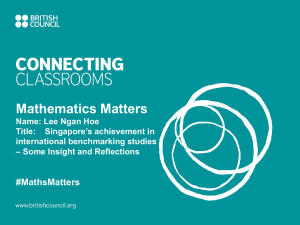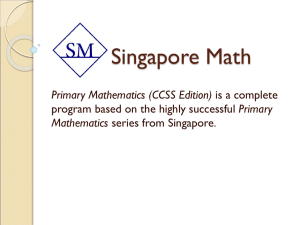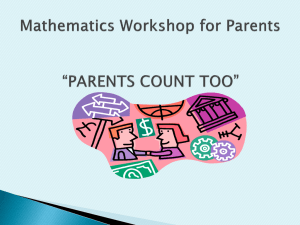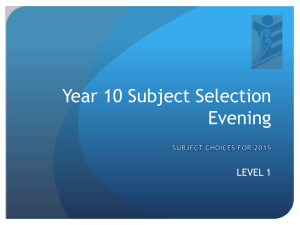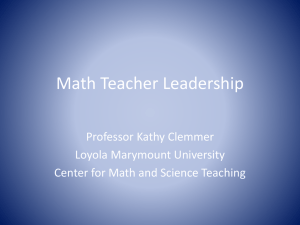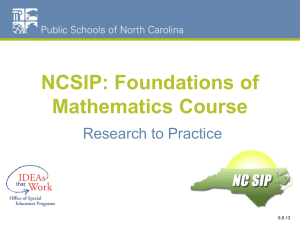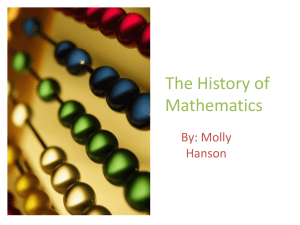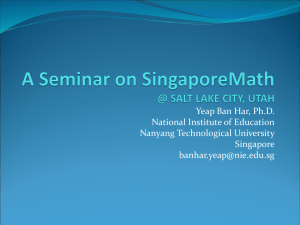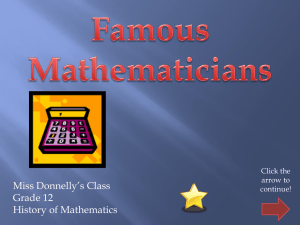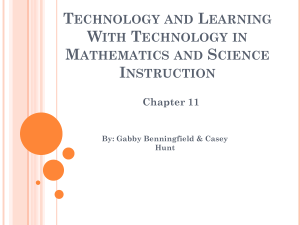PowerPoint - St. Ambrose University
advertisement
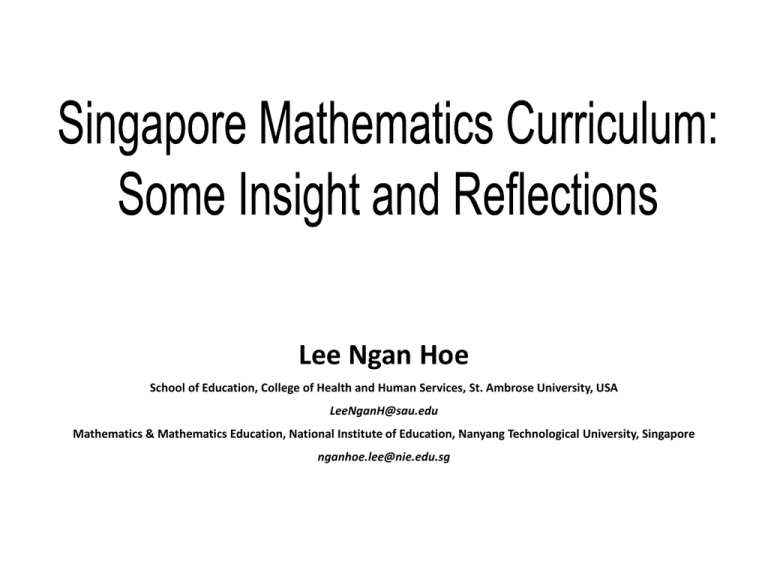
Lee Ngan Hoe School of Education, College of Health and Human Services, St. Ambrose University, USA LeeNganH@sau.edu Mathematics & Mathematics Education, National Institute of Education, Nanyang Technological University, Singapore nganhoe.lee@nie.edu.sg Singapore – A Brief Introduction The Singapore Mathematics Curriculum Reflections Concluding Comments Questions and Discussion Source: Singapore Department of Statistics - http://www.singstat.gov.sg/ Founded in : 1819 Gained independence in : 1965 People : Mainly migrants National Language : Malay Official /Working Language : English • A small country – island, city, state, country • Warm and humid • Generally safe from natural disasters and crime • Known for shopping and eating • Common use of English International Benchmarking Studies That Places Singapore In The Limelight: • TIMSS – the Trends in International Mathematics and Science Study or as previously known Third International Mathematics and Science Study • PISA – Programme for International Student Assessment • TEDS-M – Teacher Education and Development Study in Mathematics Context The Singapore Mathematics Curriculum – Basically a national curriculum: Textbooks must be approved before being adopted in schools. • • The Ministry of Education Primary Mathematics Syllabus Document (Year of implementation – 2007) (http://www.moe.edu.sg/education/syllabuses/sciences /files/maths-primary-2007.pdf) The Ministry of Education Primary Mathematics Syllabus Document (Year of implementation – 2013) (http://www.moe.edu.sg/education/syllabuses/sciences /files/maths-primary-2013.pdf) • Framework – What to address? • Approaches – How to address? The Framework for the Singapore Mathematics Curriculum, developed in 1990, for example, survived, with minor modification, the major curriculum review for the 2000 syllabuses which took into account the three new Initiatives. One of the key reasons for the Framework’s survival is its rigour and robustness in presenting the philosophy and principles underlying decisions made about what mathematics education should equip our students with. Lee, N.H. (2008). Nation Building Initiative: Impact on Singapore Mathematics Curriculum. In Niss, M. (Ed.) 10th International Congress on Mathematical Education Proceedings (CD). Copenhagen: Roskilde University. Mathematical knowledge Sense-making Facts Procedures Applications Performance Connection Automaticity Fluency Flexibility Problem Solving Teaching for Problem Solving Teaching of Problem Solving Teaching through Problem Solving Promotion Of Effectiveness Efficiency Elegance What is the value of 1 2 + 1 4 + 1 8 + 1 16 + 1 32 + 1 64 + ...? n 1 1 1 1 1 1 + + + + + + . . .= 1 2 4 8 16 32 64 n 1 2 3 4 5 6 7 8 9 10 11 12 13 14 15 16 17 18 19 20 21 22 23 24 25 26 27 28 29 30 31 32 33 2 4 8 16 32 64 128 256 512 1024 2048 4096 8192 16384 32768 65536 131072 262144 524288 1048576 2097152 4194304 8388608 16777216 33554432 67108864 134217728 268435456 536870912 1073741824 2147483648 4294967296 8589934592 0.5 0.25 0.125 0.0625 0.03125 0.015625 0.0078125 0.00390625 0.001953125 0.000976563 0.000488281 0.000244141 0.00012207 6.10352E-05 3.05176E-05 1.52588E-05 7.62939E-06 3.8147E-06 1.90735E-06 9.53674E-07 4.76837E-07 2.38419E-07 1.19209E-07 5.96046E-08 2.98023E-08 1.49012E-08 7.45058E-09 3.72529E-09 1.86265E-09 9.31323E-10 4.65661E-10 2.32831E-10 1.16415E-10 0.5 0.75 0.875 0.9375 0.96875 0.984375 0.9921875 0.99609375 0.998046875 0.999023438 0.999511719 0.999755859 0.99987793 0.999938965 0.999969482 0.999984741 0.999992371 0.999996185 0.999998093 0.999999046 0.999999523 0.999999762 0.999999881 0.99999994 0.99999997 0.999999985 0.999999993 0.999999996 0.999999998 0.999999999 1 1 1 1 2 3 4 5 6 7 8 9 10 11 12 13 14 15 16 17 18 19 20 21 22 23 24 25 26 27 28 29 30 31 32 33 34 35 36 37 38 39 40 41 42 43 44 45 46 47 48 49 50 51 52 53 54 55 56 57 58 59 60 61 62 63 64 65 66 67 68 69 70 71 72 73 74 75 76 77 78 79 80 81 82 83 84 85 86 87 88 89 90 91 92 93 94 95 96 97 98 99 100 2 4 8 16 32 64 128 256 512 1024 2048 4096 8192 16384 32768 65536 131072 262144 524288 1048576 2097152 4194304 8388608 16777216 33554432 67108864 134217728 268435456 536870912 1073741824 2147483648 4294967296 8589934592 17179869184 34359738368 68719476736 1.37439E+11 2.74878E+11 5.49756E+11 1.09951E+12 2.19902E+12 4.39805E+12 8.79609E+12 1.75922E+13 3.51844E+13 7.03687E+13 1.40737E+14 2.81475E+14 5.6295E+14 1.1259E+15 2.2518E+15 4.5036E+15 9.0072E+15 1.80144E+16 3.60288E+16 7.20576E+16 1.44115E+17 2.8823E+17 5.76461E+17 1.15292E+18 2.30584E+18 4.61169E+18 9.22337E+18 1.84467E+19 3.68935E+19 7.3787E+19 1.47574E+20 2.95148E+20 5.90296E+20 1.18059E+21 2.36118E+21 4.72237E+21 9.44473E+21 1.88895E+22 3.77789E+22 7.55579E+22 1.51116E+23 3.02231E+23 6.04463E+23 1.20893E+24 2.41785E+24 4.8357E+24 9.67141E+24 1.93428E+25 3.86856E+25 7.73713E+25 1.54743E+26 3.09485E+26 6.1897E+26 1.23794E+27 2.47588E+27 4.95176E+27 9.90352E+27 1.9807E+28 3.96141E+28 7.92282E+28 1.58456E+29 3.16913E+29 6.33825E+29 1.26765E+30 0.5 0.25 0.125 0.0625 0.03125 0.015625 0.0078125 0.00390625 0.001953125 0.000976563 0.000488281 0.000244141 0.00012207 6.10352E-05 3.05176E-05 1.52588E-05 7.62939E-06 3.8147E-06 1.90735E-06 9.53674E-07 4.76837E-07 2.38419E-07 1.19209E-07 5.96046E-08 2.98023E-08 1.49012E-08 7.45058E-09 3.72529E-09 1.86265E-09 9.31323E-10 4.65661E-10 2.32831E-10 1.16415E-10 5.82077E-11 2.91038E-11 1.45519E-11 7.27596E-12 3.63798E-12 1.81899E-12 9.09495E-13 4.54747E-13 2.27374E-13 1.13687E-13 5.68434E-14 2.84217E-14 1.42109E-14 7.10543E-15 3.55271E-15 1.77636E-15 8.88178E-16 4.44089E-16 2.22045E-16 1.11022E-16 5.55112E-17 2.77556E-17 1.38778E-17 6.93889E-18 3.46945E-18 1.73472E-18 8.67362E-19 4.33681E-19 2.1684E-19 1.0842E-19 5.42101E-20 2.71051E-20 1.35525E-20 6.77626E-21 3.38813E-21 1.69407E-21 8.47033E-22 4.23516E-22 2.11758E-22 1.05879E-22 5.29396E-23 2.64698E-23 1.32349E-23 6.61744E-24 3.30872E-24 1.65436E-24 8.27181E-25 4.1359E-25 2.06795E-25 1.03398E-25 5.16988E-26 2.58494E-26 1.29247E-26 6.46235E-27 3.23117E-27 1.61559E-27 8.07794E-28 4.03897E-28 2.01948E-28 1.00974E-28 5.04871E-29 2.52435E-29 1.26218E-29 6.31089E-30 3.15544E-30 1.57772E-30 7.88861E-31 0.5 0.75 0.875 0.9375 0.96875 0.984375 0.9921875 0.99609375 0.998046875 0.999023438 0.999511719 0.999755859 0.99987793 0.999938965 0.999969482 0.999984741 0.999992371 0.999996185 0.999998093 0.999999046 0.999999523 0.999999762 0.999999881 0.99999994 0.99999997 0.999999985 0.999999993 0.999999996 0.999999998 0.999999999 1 1 1 1 1 1 1 1 1 1 1 1 1 1 1 1 1 1 1 1 1 1 1 1 1 1 1 1 1 1 1 1 1 1 1 1 1 1 1 1 1 1 1 1 1 1 1 1 1 1 1 1 1 1 1 1 1 1 1 1 1 1 1 1 1 1 1 1 1 1 Unit Square Unit Length 1 4 1 2 Unit Length 1 8 1 2 + 1 4 + 1 8 + 1 16 + 1 32 + 1 16 1 32 1 64 1 64 + ... = 1 S = 1 2 + 1 4 + 1 8 + 1 16 2S = 1 + 1 2 + 1 4 + 1 8 2S = 1 + S S = 1 + + 1 32 1 16 + + 1 64 1 32 + . . . + 1 64 + . . . Recognized that it is a Geometric Progression (GP), with first term a = 1 1 2 and common ratio r = , and the required answer is the sum to infinity, which exists since r < 1. This 2 approach is generalizable to any GP with r < 1. Lead to problem posing – rather than consumers of mathematics, students are encouraged to be creators of mathematics. Each topic is revisited and introduced in increasing depth from one level to the next to enable students to consolidate the concepts and skills learned and to develop these concept and skills further. It is not just about representing an idea in different forms, it is about connecting the various representation to make sense of the mathematics to be learnt http://www.flashlightcreative.net/swf/mindreader/ • Eclectic approach towards teaching and learning of mathematics in a centralised system • Consistency-based and integrated approach towards curriculum changes • Value on education and mathematics • Exposure to eclecticism, striking for balance, strive for unity • Size • East or West? Advantages In International Benchmarking Studies • Every school is a good school concept: Raising the average • National examinations • Emphasise on strategic use of Information and Communication Technology Are International Benchmarking Studies Useful? What have we gained? • Economically • Educationally One way to help Americans excel at math is to copy the approach of the Japanese, Chinese, and Koreans. In Intelligence and How to Get It, Nisbett describes how the educational systems of East Asian countries focus more on hard work than on inborn talent: 1. “Children in Japan go to school about 240 days a year, whereas children in the United States go to school about 180 days a year.” 2. “Japanese high school students of the 1980s studied 3 ½ hours a day, and that number is likely to be, if anything, higher today.” 3. “[The inhabitants of Japan and Korea] do not need to read this book to find out that intelligence and intellectual accomplishment are highly malleable. Confucius set that matter straight twenty-five hundred years ago.” 4. “When they do badly at something, [Japanese, Koreans, etc.] respond by working harder at it.” 5. “Persistence in the face of failure is very much part of the Asian tradition of selfimprovement. And [people in those countries] are accustomed to criticism in the service of self-improvement in situations where Westerners avoid it or resent it.” We certainly don’t want America’s education system to copy everything Japan does (and we remain agnostic regarding the wisdom of Confucius). But it seems to us that an emphasis on hard work is a hallmark not just of modern East Asia, but of America’s past as well. In returning to an emphasis on effort, America would be returning to its roots, not just copying from successful foreigners. Source: The Atlantic – The Myth of ‘I’m Bad at Math (2013) http://www.theatlantic.com/education/print/2013/10/the-myth-of-im-badat-math/280914/ Education is embedded in a sociocultural context. Curriculum development should be approached from a integrative rather than additive manner, reflecting and refining the aspiration of the people. International benchmark studies is but just one way to better understand the gaps that exist in curriculum, teaching and learning. A balanced and holistic approach is needed for curriculum development. Thank You & All the Best! It has been great being part of this community. You may continue to contact me at: leenganhoe@gmail.com Recognized that it is a Geometric Progression (GP), with first term a = 1 1 2 and common ratio r = 2, and the required answer is the sum to infinity, which exists since r < 1. This approach is generalizable to any GP with r < 1. S a + ar + ar2 + ar3 + ar4 + ... = 𝑆 𝑎 = 𝑟 S 𝑟 a = r r 1 a r r S ( – 1) = S( 1− 𝑟 S = r )= a 1−r a r + a + ar1 + ar2 + ar3 + ar4 + ... + S Let AB be the 2-digit number. So, A = 1, 2, 3, 4, ..., 7, 8, 9 and B = 0, 1, 2, 3, 4, ..., 7, 8, 9 The value of AB is: 10 × A + B. The value of sum of the two digits is: A + B. So, your answer is: 10 × A + B – (A + B) = 9 × A In other words, your answer is 9, 18, 27, 36, 45, 54, 63, 72, 81.
